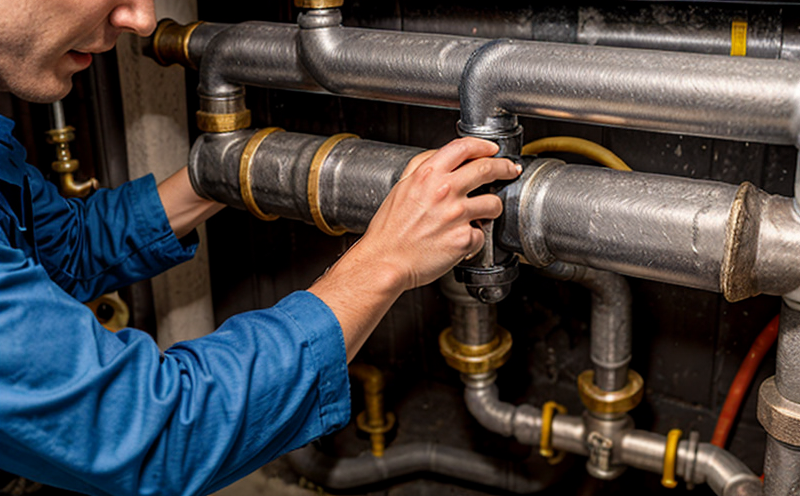Plumbing pipe installation inspection
The inspection of plumbing pipe installations is a critical process in ensuring that water supply and drainage systems meet safety standards and operational requirements. This service involves detailed examination of pipes, fittings, joints, and valves to confirm compliance with relevant international standards such as AS/NZS 3500.1:2018, ISO 15679:2018, ASTM F1740-15, and EN 13485:2010. The primary goal is to prevent leaks, ensure water quality, and enhance the longevity of plumbing systems.
During this inspection, our experts use advanced tools like electronic leak detectors, ultrasonic thickness gauges, and visual inspection devices. Specimen preparation involves reviewing blueprints, inspecting all installed pipes, and verifying that joints are properly sealed with appropriate materials such as polyvinyl chloride (PVC), copper, or lead-free brass.
Acceptance criteria for this service include adherence to the specified standards, proper installation of fittings and valves, and confirmation that the system can withstand pressure tests without leakage. Our team provides detailed reports that outline any deviations from these criteria along with recommendations for corrective actions where necessary.
The process begins by identifying all components involved in the plumbing system, including supply lines, waste disposal systems, and drainage pipes. Each component is examined individually to ensure it meets the required specifications before being integrated into the overall installation.
Our team recommends routine inspections of plumbing systems every five years or whenever significant changes are made to the structure or layout of buildings. Regular checks help identify potential issues early on and prevent costly repairs down the line.
| Component | Description |
|---|---|
| PVC Pipes | Commonly used for cold water supplies due to their durability and ease of installation. |
| Copper Pipelines | Preferred for hot water applications because they resist corrosion better than PVC materials. |
| Lead-Free Brass Fittings | Ensures compliance with health regulations by minimizing lead exposure risks associated with traditional brass fittings. |
| Type of Inspection | Description |
|---|---|
| Visual Inspection | Involves checking visible parts of the plumbing system for signs of wear or damage. |
| Pressure Testing | Tests the integrity of installed pipes under simulated working conditions to detect leaks. |
| Leak Detection | Uses specialized equipment to pinpoint areas where water may be escaping from the system. |
In summary, plumbing pipe installation inspection plays a vital role in maintaining safe and efficient building infrastructure. By adhering to strict standards and employing thorough examination techniques, we ensure that every aspect of your plumbing systems meets the highest quality benchmarks.
Why Choose This Test
Selecting our plumbing pipe installation inspection service offers several advantages over other options available in the market. Our team comprises highly qualified professionals with extensive experience in both residential and commercial projects, ensuring comprehensive coverage of all relevant aspects during inspections.
- Comprehensive Coverage: We examine every part of your plumbing system to ensure full compliance with international standards.
- Expertise: Our inspectors possess the necessary skills and knowledge required for accurate assessments based on decades of industry experience.
- Timely Reporting: You receive detailed reports promptly after completion so you can address any issues identified immediately.
- Cost-Effective Solutions: By catching problems early through regular inspections, we help avoid more expensive repairs later down the road.
In addition to these benefits, choosing our service means peace of mind knowing that your plumbing installations are up-to-date and safe. Our commitment to excellence ensures you receive reliable results every time, allowing you to focus on other aspects of your projects without worrying about hidden risks within your water systems.
Environmental and Sustainability Contributions
The inspection of plumbing pipe installations also contributes positively towards environmental sustainability goals. Properly installed and maintained plumbing systems reduce waste by minimizing leaks, which can lead to significant water savings over time. This not only helps conserve resources but also reduces energy consumption associated with heating or cooling water unnecessarily.
Furthermore, using materials like PVC and copper that are recyclable contributes to a circular economy approach, promoting responsible disposal practices at the end of their lifecycle. By ensuring your plumbing systems operate efficiently, we contribute to reduced greenhouse gas emissions from wastewater treatment plants and lower demands on fresh water supplies.
Incorporating sustainable design principles into new builds or renovations is crucial for creating structures that are environmentally friendly and resource-efficient. Our inspection services support this goal by identifying areas where improvements can be made during the installation phase, resulting in long-term benefits for both your organization and the planet.





